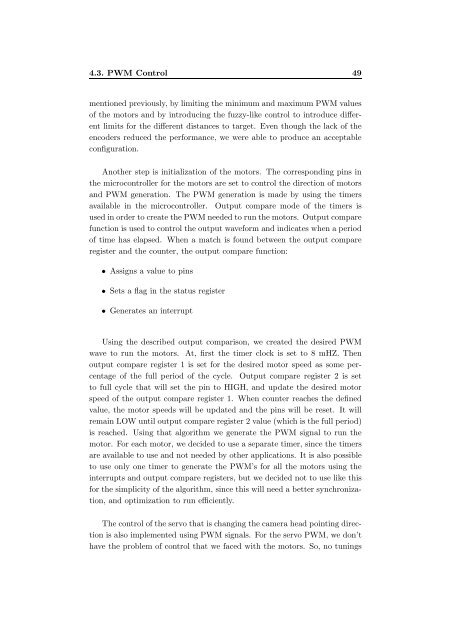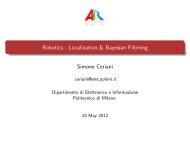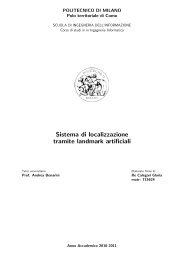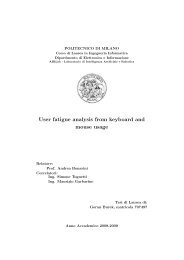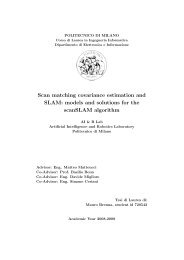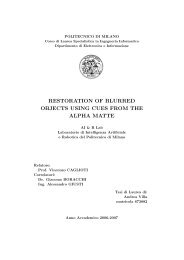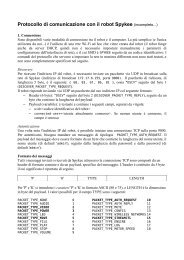Submitted version of the thesis - Airlab, the Artificial Intelligence ...
Submitted version of the thesis - Airlab, the Artificial Intelligence ...
Submitted version of the thesis - Airlab, the Artificial Intelligence ...
Create successful ePaper yourself
Turn your PDF publications into a flip-book with our unique Google optimized e-Paper software.
4.3. PWM Control 49<br />
mentioned previously, by limiting <strong>the</strong> minimum and maximum PWM values<br />
<strong>of</strong> <strong>the</strong> motors and by introducing <strong>the</strong> fuzzy-like control to introduce different<br />
limits for <strong>the</strong> different distances to target. Even though <strong>the</strong> lack <strong>of</strong> <strong>the</strong><br />
encoders reduced <strong>the</strong> performance, we were able to produce an acceptable<br />
configuration.<br />
Ano<strong>the</strong>r step is initialization <strong>of</strong> <strong>the</strong> motors. The corresponding pins in<br />
<strong>the</strong> microcontroller for <strong>the</strong> motors are set to control <strong>the</strong> direction <strong>of</strong> motors<br />
and PWM generation. The PWM generation is made by using <strong>the</strong> timers<br />
available in <strong>the</strong> microcontroller. Output compare mode <strong>of</strong> <strong>the</strong> timers is<br />
usedinordertocreate <strong>the</strong>PWMneededtorun<strong>the</strong>motors. Outputcompare<br />
function is used to control <strong>the</strong> output waveform and indicates when a period<br />
<strong>of</strong> time has elapsed. When a match is found between <strong>the</strong> output compare<br />
register and <strong>the</strong> counter, <strong>the</strong> output compare function:<br />
• Assigns a value to pins<br />
• Sets a flag in <strong>the</strong> status register<br />
• Generates an interrupt<br />
Using <strong>the</strong> described output comparison, we created <strong>the</strong> desired PWM<br />
wave to run <strong>the</strong> motors. At, first <strong>the</strong> timer clock is set to 8 mHZ. Then<br />
output compare register 1 is set for <strong>the</strong> desired motor speed as some percentage<br />
<strong>of</strong> <strong>the</strong> full period <strong>of</strong> <strong>the</strong> cycle. Output compare register 2 is set<br />
to full cycle that will set <strong>the</strong> pin to HIGH, and update <strong>the</strong> desired motor<br />
speed <strong>of</strong> <strong>the</strong> output compare register 1. When counter reaches <strong>the</strong> defined<br />
value, <strong>the</strong> motor speeds will be updated and <strong>the</strong> pins will be reset. It will<br />
remain LOW until output compare register 2 value (which is <strong>the</strong> full period)<br />
is reached. Using that algorithm we generate <strong>the</strong> PWM signal to run <strong>the</strong><br />
motor. For each motor, we decided to use a separate timer, since <strong>the</strong> timers<br />
are available to use and not needed by o<strong>the</strong>r applications. It is also possible<br />
to use only one timer to generate <strong>the</strong> PWM’s for all <strong>the</strong> motors using <strong>the</strong><br />
interrupts and output compare registers, but we decided not to use like this<br />
for <strong>the</strong> simplicity <strong>of</strong> <strong>the</strong> algorithm, since this will need a better synchronization,<br />
and optimization to run efficiently.<br />
The control <strong>of</strong> <strong>the</strong> servo that is changing <strong>the</strong> camera head pointing direction<br />
is also implemented using PWM signals. For <strong>the</strong> servo PWM, we don’t<br />
have <strong>the</strong> problem <strong>of</strong> control that we faced with <strong>the</strong> motors. So, no tunings


